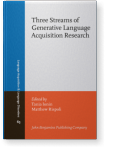The acquisition of V-V compounds in Japanese
Japanese verbal compounds (V-V compounds) are known to consist of two verbs where a first verb in the preverbal form is adjoined to a second verb. Theoretical studies have demonstrated that there are two types of V-V compounds in Japanese: lexical and syntactic V-V compounds. Although the two classes of V-V compounds are superficially similar, they are notably distinct in many syntactic and semantic aspects and thus a question arises as to how children come to distinguish these two types of compounds. This study examines whether Japanese-speaking children aged 4–5 can differentiate the two types of Japanese V-V compounds. Our experiment revealed that there is a developmental stage in which children have acquired lexical V-V compounds but not syntactic ones.
Article outline
- 1.Introduction
- 2.Previous studies
- 2.1Syntactic background
- 2.2Acquisition studies
- 2.2.1Lexical V-V compounds
- 2.2.2Syntactic V-V compounds
- 3.Experiment
- 3.1Method
- 3.1.1Participants
- 3.1.2Procedure and materials
- 3.2Results
- 4.Discussion and concluding remarks
-
Acknowledgement
-
Notes
-
References
References (28)
References
Alsina, A., Bresnan, J., & Sells, P. (Eds.). (1997). Complex predicates. Stanford, CA: CSLI.
Amberber, M., Baker, B., & Harvey, M. (Eds.). (2010). Complex predicates: Cross-linguistic perspectives on event structure. Cambridge: CUP. 

Isobe, M., Okabe, R., & Kido, Y. (2014). Lexical V-V compounds in child Japanese: An experimental study. Paper presented at the 9th International Workshop on Theoretical East Asian Linguistics, Nantes, France, September.
Isobe, M., Okabe, R., & Kido, Y. (2018). Lexical V-V compounds in child Japanese: An experimental study. Journal of Japanese Linguistics, 34, 3–21. doi: 

Kageyama, T. (1993). Bumpoo to gokeisei [Grammar and word formation]. Tokyo: Hituzi Syobo.
Kageyama, T. (2013). Goiteki fukugodosi-no sin-taikei [A new architecture of lexical compound verbs]. In T. Kageyama (Ed.), Fukugodosi-kenkyu-no sai-sentan [New explorations into the mysteries of compound verbs] (pp.3–46). Tokyo: Hituzi Syobo.
Kageyama, T. (2016a). Agents in anticausative and decausative compound verbs. In T. Kageyama & W. M. Jacobsen (Eds.), Transitivity and valency alternations: Studies on Japanese and beyond (pp.89–124). Berlin: Walter de Gruyter. 

Kageyama, T. (2016b). Verb-compounding and verb-incorporation. In T. Kageyama & H. Kishimoto (Eds.), Handbook of Japanese lexicon and word formation (pp.273–310). Berlin: Walter de Gruyter. 

Kido, Y. (2013). Nihongo-o bogo-to-suru yoji-niyoru fukugodosi-no kakutoku [Acquisition of complex verbs by native Japanese-speaking children] (Unpublished MA thesis). Nanzan University, Nagoya.
Kido, Y. (2015). Goiteki fukugodosi-no kakutoku: CHILDES-o siyo-sita jissyo-kenkyu [Acquisition of complex verbs: An empirical study using CHILDES]. KLS, 35, 61–72.
Kido, Y. (2016). Nihongo fukugodosi no kakutoku – Niju mekanizumu moderu no kanten kara – [The acquisition of V-V compounds in child Japanese: From the dual mechanism model perspective]. Kobe Papers in Linguistics, 10, 1–23.
Kishimoto, H., & Y. Yumoto (Eds.). (2014). Fukuzatu-jutugo kenkyu no genzai [Current issues in complex predicate research]. Tokyo: Hituzi Syobo.
MacWhinney, B. (2000). The CHILDES project: Tools for analyzing talk (3rd ed.). Mahwah, NJ: Lawrence Erlbaum Associates.
Miyata, S. (2004a). Japanese: Miyata-Aki Corpus. Pittsburgh, PA: TalkBank.
Miyata, S. (2004b). Japanese: Miyata-Ryo Corpus. Pittsburgh, PA: TalkBank.
Miyata, S. (2004c). Japanese: Miyata-Tai Corpus. Pittsburgh, PA: TalkBank.
Miyata, S., & Nisisawa, H. (2009). Japanese: MiiPro-Asato Corpus. Pittsburgh, PA: TalkBank.
Miyata, S., & Nisisawa, H. (2010). Japanese: MiiPro-Tomito Corpus. Pittsburgh, PA: TalkBank.
Morita, Y. (1994). Doosi-no imiron-teki bumpo kenkyu [Semantic grammar resaerch on verbs]. Tokyo: Meiji Shoin.
Nakatani, K. (2003). Analyzing ‑te. In W. McClure (Ed.), Japanese/Korean Linguistics, 12 (pp.377–387). Stanford, CA: CSLI.
National Institute for Japanese Language and Linguistics. (2013–2015). The compound verb lexicon [Software]. Retrieved from <[URL]>

Nisisawa, H., & Miyata, S. (2009). Japanese: MiiPro-Nanami Corpus. Pittsburgh, PA: TalkBank.
Nisisawa, H., & Miyata, S. (2010). Japanese: MiiPro-ArikaM Corpus. Pittsburgh, PA: TalkBank.
Noji J., Naka, N., & Miyata, S. (2004). Japanese: Noji Corpus. Pittsburgh, PA: TalkBank.
Okabe, R. & Isobe, M. (2015). Nihongo no togoteki fukugodosi no kakutoku: rikai jikken o tosite [The acquisition of Japanese syntactic V-V compounds: Through a comprehension experiment]. Paper presented at the 151st Meeting of the Linguistic Society of Japan, Nagoya, Japan, November.
Okubo, A. (1967). Yooji gengo no hattatu [Child language development]. Tokyo: Tokyodo.
Oshima-Takane, Y., MacWhinney, B., Sirai, H., Miyata, S., & Naka, N. (Eds.). (1998). CHILDES for Japanese (2nd ed.). The JCHAT Project. Nagoya: Chukyo University.
Saito, M. (2014). Case and labeling in a language without φ-feature agreement. In A. Cardinaletti, G. Cinque, & Y. Endo (Eds.). On peripheries (pp.269–297). Tokyo: Hituzi Syobo.
